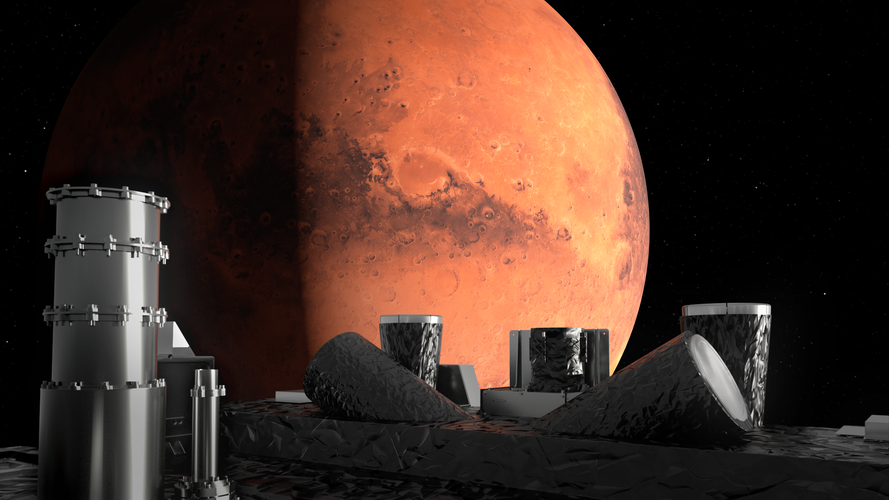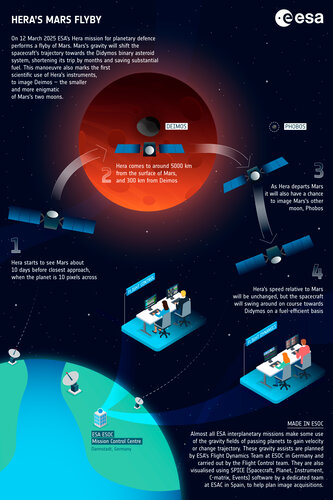
Copernical Team
ESA’s pioneering Biomass satellite arrives at launch site

Marking another step towards new insights into Earth’s forests and their role in the carbon cycle, ESA’s groundbreaking Biomass satellite has arrived at Europe's Spaceport in French Guiana, to be prepared for liftoff on a Vega-C rocket at the end of April.
Hera: Target Deimos
 Image:
Hera: Target Deimos
Image:
Hera: Target Deimos Watch live: Images from Hera’s Mars flyby

Join us live for a star-studded event this Thursday, as scientists working on ESA’s Hera mission for planetary defence release the mission’s first scientific observations beyond the Earth-Moon system, following its imminent flyby of Mars.
Hera asteroid mission’s Mars flyby
 Video:
00:01:36
Video:
00:01:36
On Wednesday 12 March 2025 ESA’s Hera spacecraft for planetary defence performs a flyby of Mars. The gravity of the red planet shifts the spacecraft’s trajectory towards its final destination of the Didymos binary asteroid system, shortening its trip by months and saving substantial fuel.
Watch the livestream release of images from Hera’s flyby by the mission’s science team on Thursday 13 March, starting at 11:50 CET!
Hera comes to around 5000 km from the surface of Mars during its flyby. It will also image Deimos, the smaller of Mars’s two moons, from a minimum 1000 km away (while
NASA rolls out Artemis II Orion spacecraft, twin rocket boosters for moon mission
 NASA on Friday rolled out the new Artemis II Orion spacecraft and twin Space Launch System solid rocket boosters that will carry astronauts in the first crewed Artemis mission around the moon.
That lunar flyby mission carrying four astronauts is set for launch in April 2026. It's a flight test mission that will pave the way for landing the first woman and the next man on the moon.
NASA on Friday rolled out the new Artemis II Orion spacecraft and twin Space Launch System solid rocket boosters that will carry astronauts in the first crewed Artemis mission around the moon.
That lunar flyby mission carrying four astronauts is set for launch in April 2026. It's a flight test mission that will pave the way for landing the first woman and the next man on the moon. Oops, we tipped it again: Mission over for sideways US lander
 Intuitive Machines' second Moon mission ended in disappointment on Friday after the US company confirmed that its spacecraft had tipped over and was unable to recharge its solar-powered batteries - mirroring its first attempt last year.
It marked a premature conclusion to a mission that had sparked excitement in the space community, thanks to its cutting-edge payloads, including a futuristi
Intuitive Machines' second Moon mission ended in disappointment on Friday after the US company confirmed that its spacecraft had tipped over and was unable to recharge its solar-powered batteries - mirroring its first attempt last year.
It marked a premature conclusion to a mission that had sparked excitement in the space community, thanks to its cutting-edge payloads, including a futuristi The ART of training – part two

ESA’s second group of Astronaut Reserve members has successfully completed the first block of their intensive Astronaut Reserve Training (ART) programme. Starting in January 2025, four members of the European Astronaut Reserve—Meganne Christian from the UK, Anthea Comellini from Italy, John McFall from the UK and Carmen Possnig from Austria— tarted their two months training programme at ESA’s European Astronaut Centre (EAC) in Cologne, Germany, honing essential skills required for future space exploration and scientific research.
Women powering up space
 Image:
Image:
Europe’s human spaceflight ambitions are reaching new heights, and ESA’s Astronaut Reserve is a key part of this journey. Selected in 2022, these talented individuals are undergoing Astronaut Reserve Training (ART) to ensure they are ready for future missions.
Among these remarkable women from across Europe are Meganne Christian, a materials scientist from the UK, Anthea Comellini, an aerospace engineer from Italy, and Carmen Possnig, a medical doctor from Austria, who recently completed their first ART training block at the European Astronaut Centre (EAC) in Cologne, Germany.
Their diverse scientific backgrounds reflect the wide-ranging expertise needed for human spaceflight, whether as part of ESA’s
Close-up of Proba-3’s Coronagraph, ready to dance
 Image:
Close-up of Proba-3’s Coronagraph, ready to dance
Image:
Close-up of Proba-3’s Coronagraph, ready to dance 
 Image:
Hera Mars flyby
Image:
Hera Mars flyby 


































